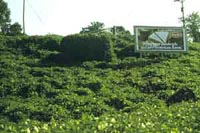Resource Library
Plant of the Week: Vine, Mile-a-minute (Kudzu)
The University of Arkansas System Division of Agriculture does not promote, support or recommend plants featured in "Plant of the Week." Please consult your local Extension office for plants suitable for your region.
Plant of the Week
Kudzu, Mile-a-Minute Vine
Latin: Pueraria lobata

Well, It seemed like a good idea at the time. Nobody could argue with the goal of helping farmers in the southeastern states recover from the depression and grow a crop on their worn out, highly eroded cotton land. But, as our mommas all told us, the road to hell is paved with good intentions. But in this case, we can’t find the road because it’s covered with a dark green vine called kudzu.
Kudzu is scattered throughout Arkansas, but to really see and appreciate the ferocity of this vine you must travel the back roads of Georgia, Alabama and the Carolinas in July. At the Kudzu Festival in Union, SC, a "measure in" is held each year with vines producing up to 85 feet of new growth in a single season. Kudzu (Pueraria lobata) is a frost tender perennial vine that will live as far north as Eureka Springs where its rampant ways are somewhat contained by the cold. In the deep South there is less dieback from frost and the vine covers everything in sight to a depth of up to 4 feet.
The joke goes that you should fertilize kudzu in a dry year with motor oil because lubricating the undersides of the leaves reduces the chance of sparks as it races across the ground. In reality, stories of birddogs being covered while on point or losing your car over night are unfounded. It only grows about a foot a day. Reports are that from 2 to 7 million acres of the south are claimed by the vine.
Kudzu is a member of the legume family with three-lobed leaves about the size of a dinner plate. It produces purple flowers down in the tangle of foliage that resembles a wisteria and flat, papery pods that are covered with tawny brown hairs. The main taproot of the plant can be as large as a leg and grow to 10 feet deep. Being a legume, it produces its own nitrogen, thus explaining its mile a minute race across the landscape.
Kudzu was introduced to the U.S. during the Philadelphia Centennial Exposition in 1876 by the Japanese, but its real spread came when government agencies started promoting its planting following the depression.
The actual history of kudzu’s spread began in 1902 when Charles Pleas of Chipley, Fla. planted the vine to hide his trash barrels. The vine grew so well that Pleas and his wife began selling kudzu cuttings through the mail from their Glen Arden Nursery about 1910. George Tabor, a Georgia county extension employee in the 1920's obtained the plant and was impressed with its growth and nutrient content - which it turns out is about the same as alfalfa.
Tabor passed the plant on to John Rigdon who was working for the Central Georgia Railroad and charged with helping farmers grow crops so the railroad could keep their boxcars full. Rigdon immediately saw the vine’s potential and thought that kudzu, either as hay or forage for cattle, would be the ideal way of keeping those boxcars rolling. The railroad began providing free kudzu vines to interested farmers.
During the depression the Soil Conservation Service picked up the kudzu ball and ran with it under the guise of preventing erosion. Working with Civilian Conservation Core workers, the SCS planted thousands of acres of the vine. In the 1940's, government programs paid an $8.00 per acre incentive for farmers to plant the vine.
One of the most colorful characters associated with kudzu was Channing Cope, who was an agricultural writer for the Atlanta-Journal-Constitution and host of a daily radio program. He joined the rush to promote kudzu in the late 1930's, but because of his media connections, Cope was really good at spreading the kudzu gospel.
In 1943 Cope started the Kudzu Club that had 20,000 faithful members. In 1949 he wrote the kudzu bible, Front Porch Farming. In it he advocated planting the entire farm to kudzu and a few other forages and growing cows.
Even while Cope was promoting kudzu, more sensible people had their reservations. He says that regardless of kudzu’s great merits, he is often cornered by what he calls "shortsighted garden club ladies" wanting to know how to kill the stuff.
But the bubble burst. People noticed that cows don’t really like kudzu and, perhaps more importantly, they can’t climb trees. By 1952 the SCS had stopped recommending planting kudzu and, believe it or not, in 1972 the USDA recognized kudzu as a weed! Attempts to kill it out have been less than promising. While a few herbicides actually make it grow better, the most effective ones take from 3 to 10 years to kill out a patch.
By: Gerald Klingaman, retired
Extension Horticulturist - Ornamentals
Extension News - August 30, 2002
The University of Arkansas System Division of Agriculture does not maintain lists of retail outlets where these plants can be purchased. Please check your local nursery or other retail outlets to ask about the availability of these plants for your growing area.